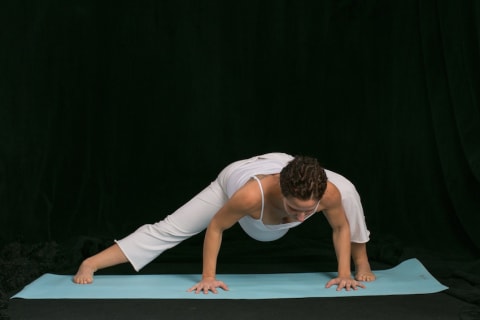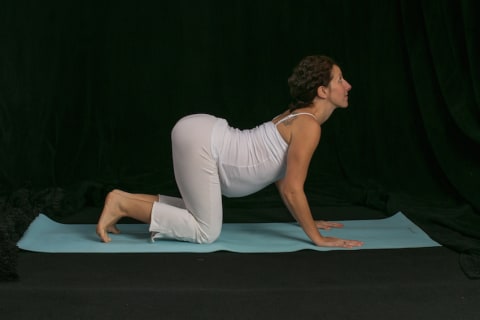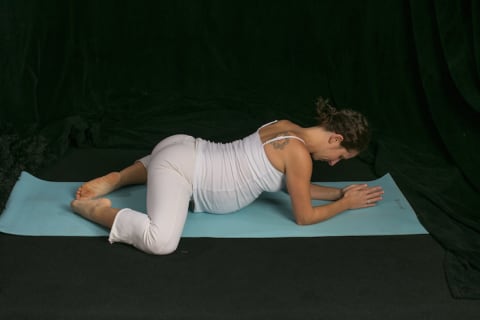Aside from nutrition, which is vital, we also need to move! And next to walking, yoga is the next best thing for a mother-to-be. As a mother of three beautiful children, and a prenatal yoga teacher trainer, I can definitely say that the pregnant body deserves a little extra TLC. When your body is expanding and preparing for the most amazing process the human body can endure, here are my five must-have prenatal moves for expectant mothers. With your feet outside of your hips, slowly lower yourself into a squat position, with your belly centered in the middle. Press your weight back into your heels as you reach and lean forward, opening the back of your back body. Tent the fingertips to your mat in front of you and start to tuck in your chin. Imagine you are hanging your heels off a ledge as you press into your heels without setting them flat to the floor. If possible, take a peek and notice if your feet turn a certain direction, and work to turn them parallel. Acknowledge if the arches are collapsed or not, and work to keep them lifted. Notice stretch through the arches, ankles, achilles tendon and calves. Breathe deeply for five long inhales and exhales. Standing with your feet parallel and your pelvis neutral, move mindfully into a Wide-Leg Forward Fold (Prasarita Padattonasana). Keep active pressure into the right foot, but be sure not to roll into the outer ankle, and begin to bend the left knee, lunging sideways to the left. Contract your baby belly (imagine lifting baby off the floor), as you use your left elbow and shoulder pressing into the left thigh, to help create space in the inner groin and hips. As you lunge to the left, keep pressure to the right leg and foot. Next, work to sit back onto an imaginary bench behind you. Breathe deeply for a few breaths and repeat the opposite side. Feel free to use a blanket or bolster behind you and come to lay on your back. Open your feet as wide as your yoga mat (or just wider than your hips). With your head relaxing in neutral (you may need a head rest), slide your arms to a T-shape or cactus position, relaxing the shoulders down toward the floor. Breathing calmly, release the left knee to fall inward and the best that you can, work to bring the left knee underneath its hip socket rather than diagonally inward. This will ensure no torque on the knee and a full hip stretch. As the left knee falls inward, the right knee falls outward. Now exaggerate the lift of the left hip, glute and left side of the lower back and spine. Allowing gravity or gentle encouragement from your own strength, let the inward falling knee move toward the floor as much as you can without pain. As a variation, you can cross the ankle of the outward falling leg over the inward falling knee, or support the outward falling leg as needed. Work each side either in a dynamic in-and-out motion using your breath, or for a longer hold on each side. On all fours, bend your elbows as you inhale and feel your sitting bones open as your tailbone turns upward. Follow that action forward as the belly drops and your sternum and heart pull off of the belly and forward between your arms. On an inhale, begin to slowly lengthen the arms keeping the shoulder girdle as open as possible, with the hands spread wide. Traction back on the arms as the heart pulls forward for more space and release. Focus on creating space in the front body and lengthening the whole spine, not just the lower back. On an exhale, follow up with Cat Pose by drawing your navel in and tucking your chin, rounding the spine upward. Otherwise, come back to a tabletop position and repeat Cow Pose several times, moving with your breath. Starting in a kneeling position with the knees drawn very wide, allow the feet to touch for the time being. Keeping gentle support of baby belly, inhale and begin to come up and forward, shifting your weight to the inner part of the knee/lower thigh bone, there should be no pain. Be mindful to not come too far forward or you will lose the stretch. Supporting your body weight either on your forearms, a yoga block, blanket or bolster placed under the chest, begin to rest your body weight down and allow your baby belly to hang with gentle core support. At this point your feet may or may not stay together. Remain here for several deep breaths or create a dynamic movement by rocking in and out of this pose for a “leaping frog.” Gallery courtesy of the author







